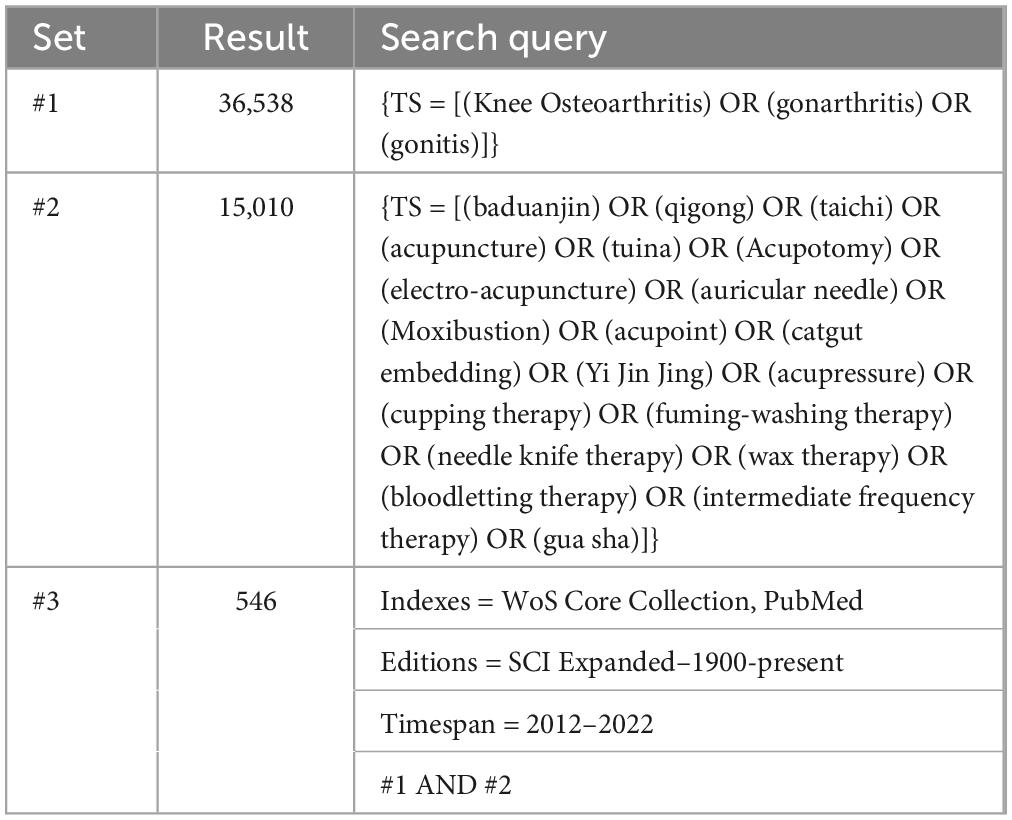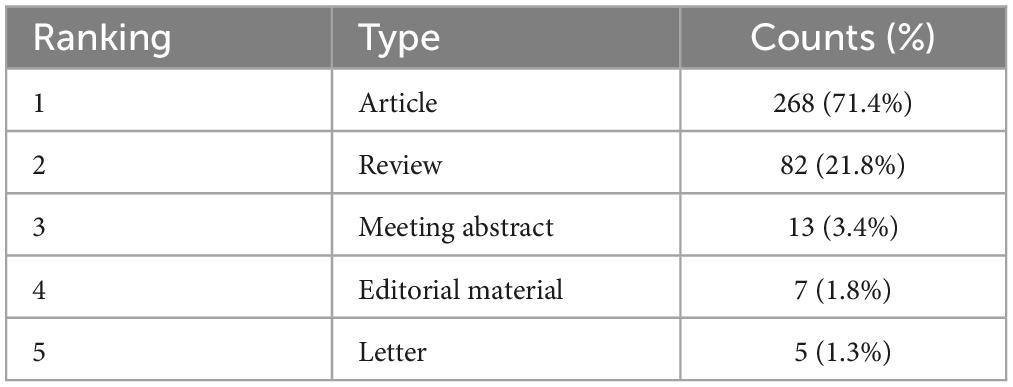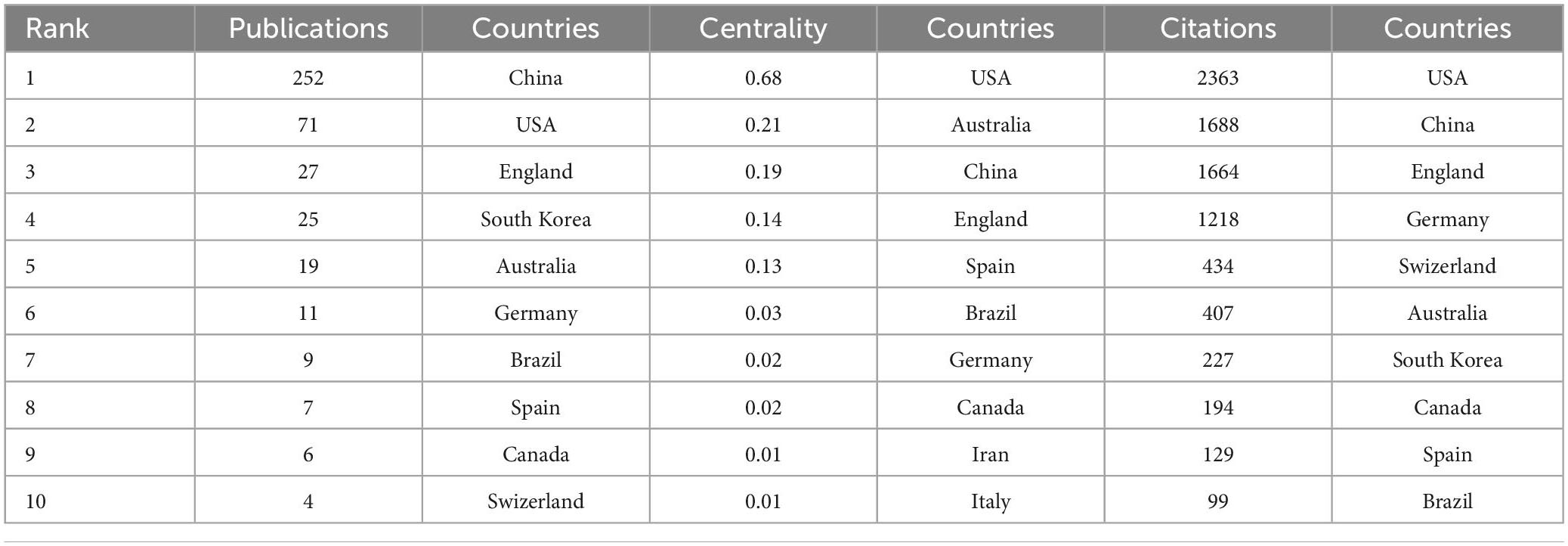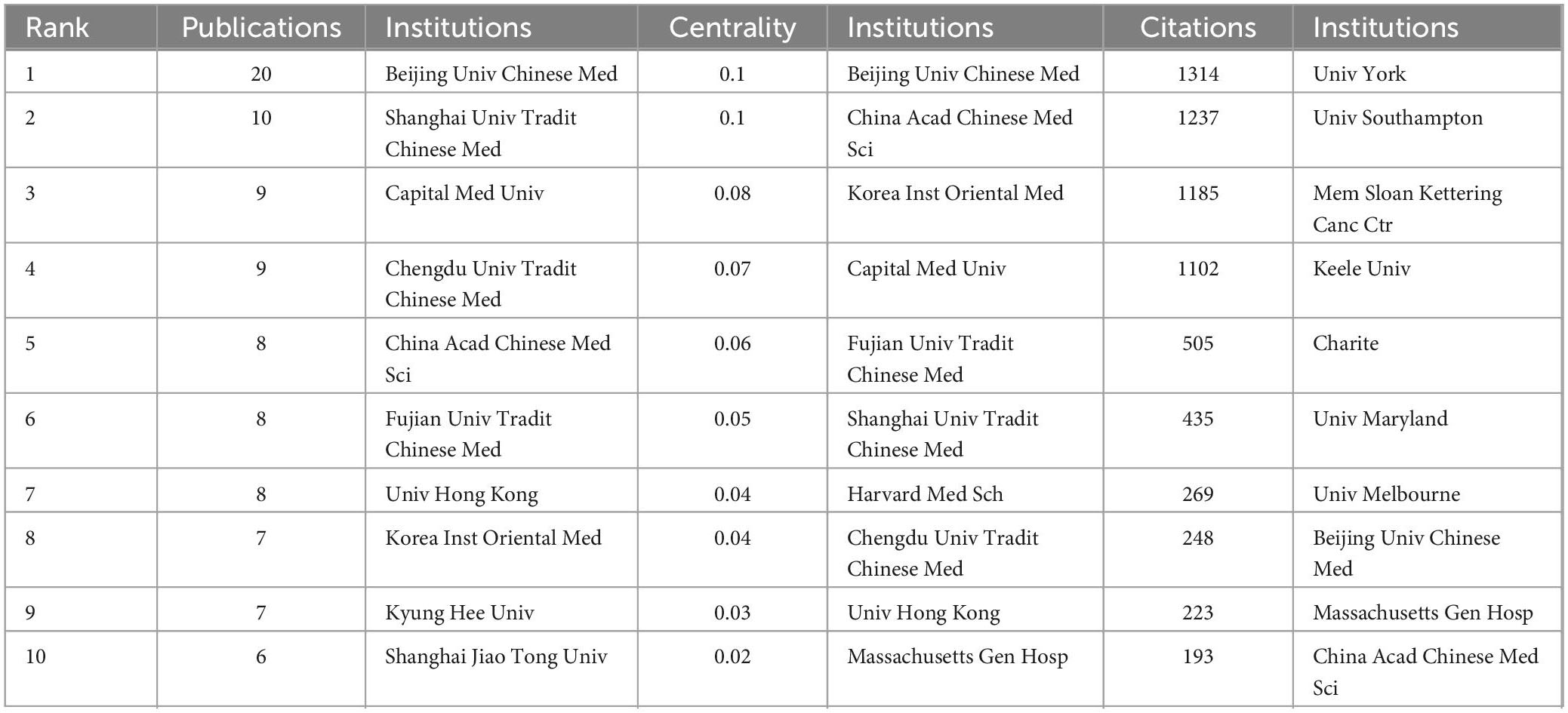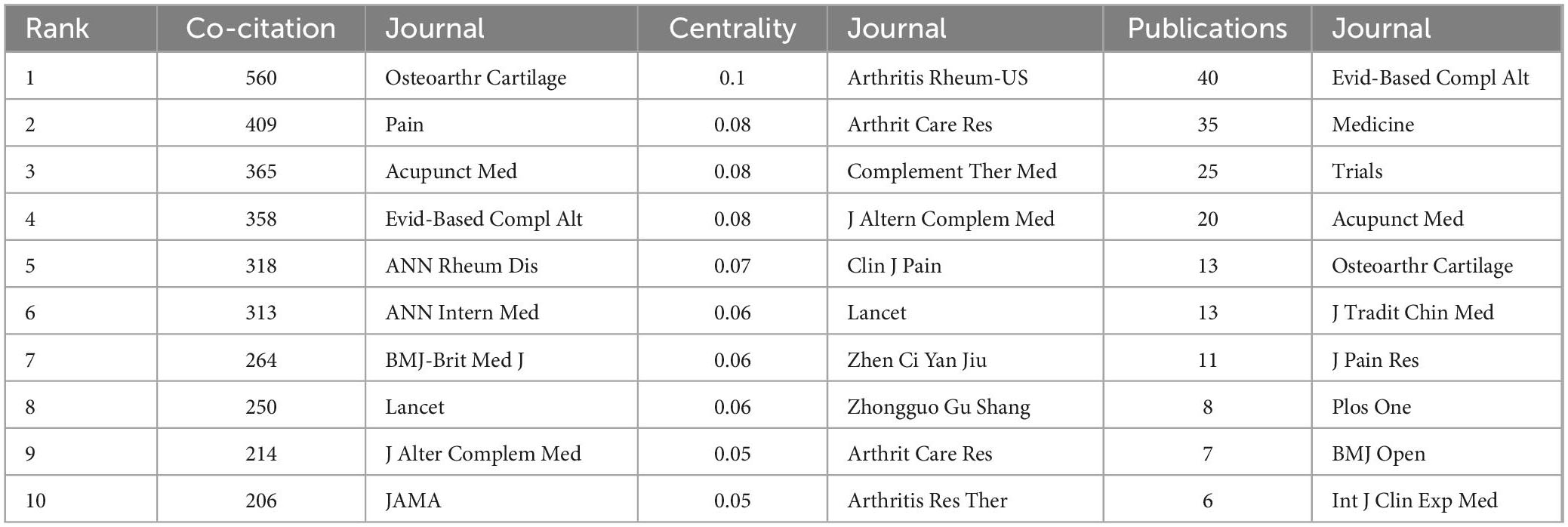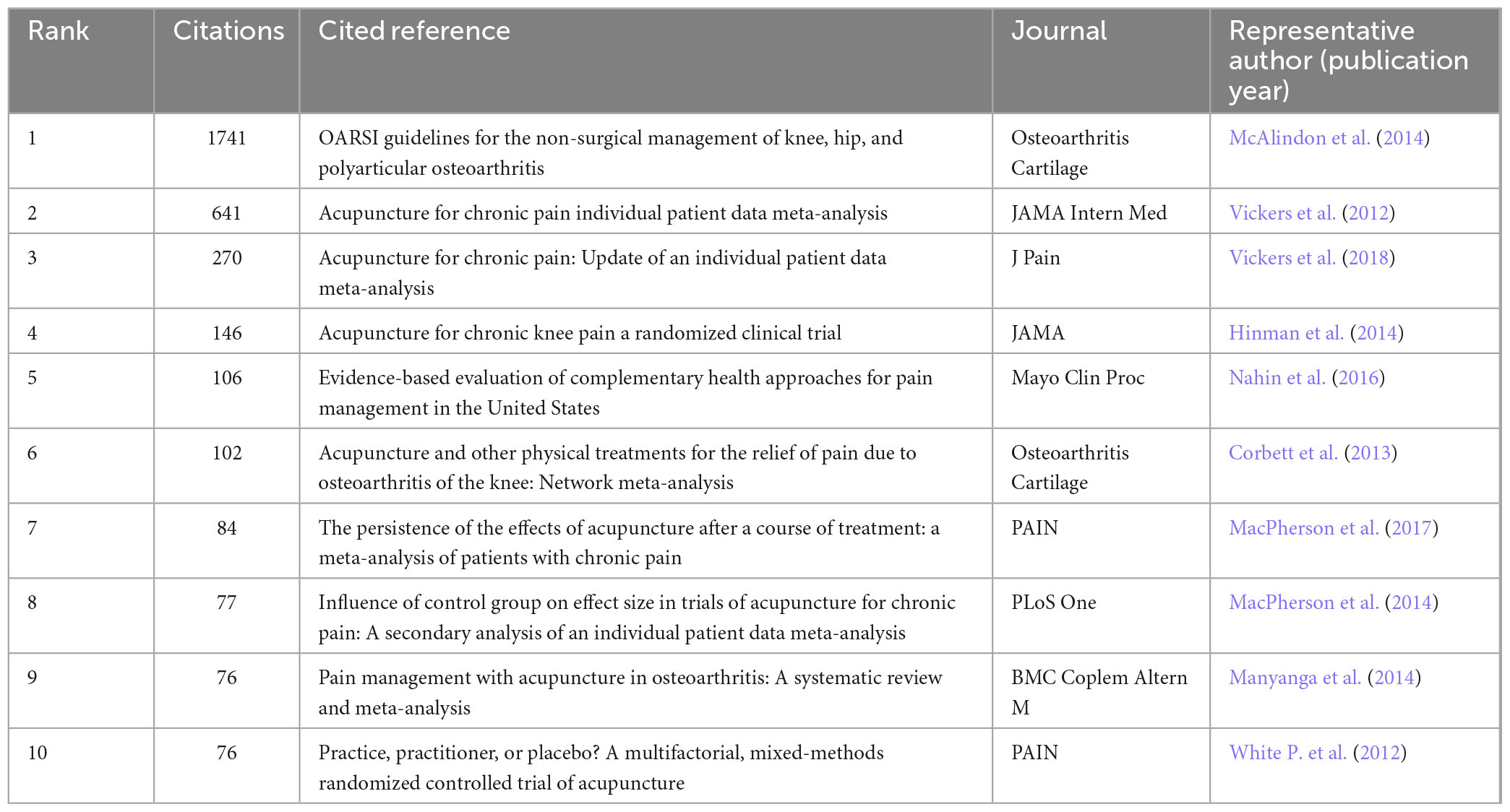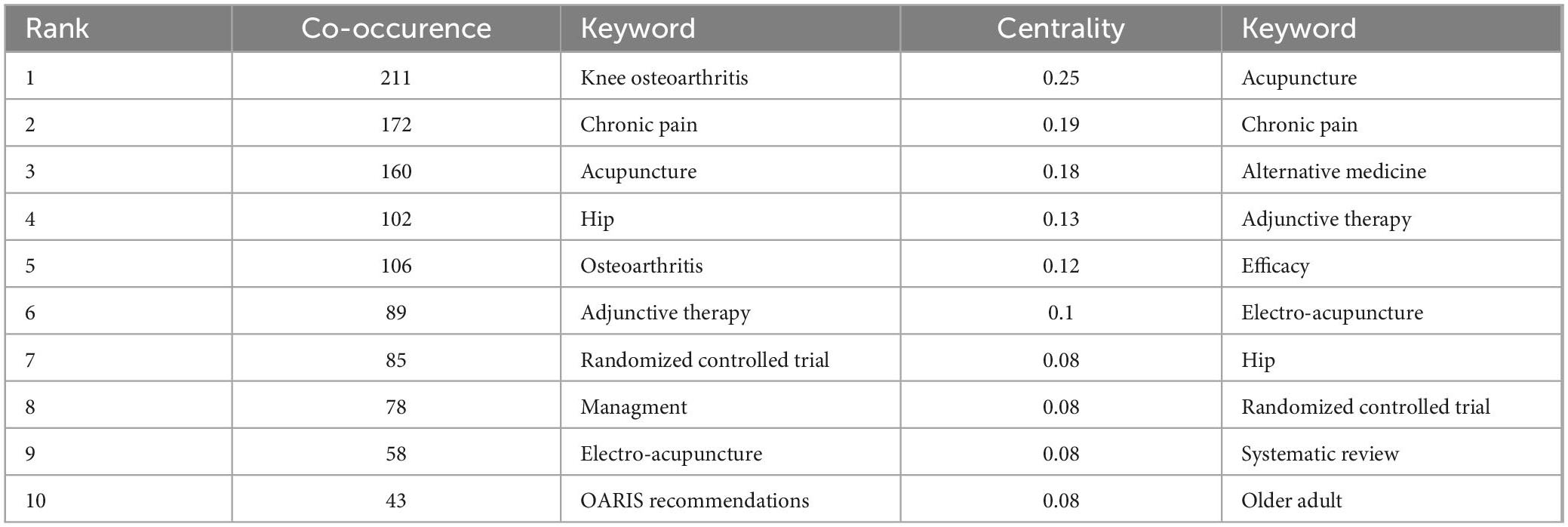- School of Second Clinical Medicine, Yunnan University of Chinese Medicine, Kunming, China
Objective: The benefits of traditional Chinese non-pharmacological therapies in the treatment of Knee osteoarthritis (KOA) are receiving increasing attention. Therefore, this study aims to systematically analyze the global research on the treatment of KOA by Chinese traditional non-pharmacological therapies using bibliometric analysis and present the results with a knowledge map form.
Methods: Literature related to traditional Chinese non-pharmacological therapies used in the treatment of KOA from 2012 to 2022 was searched from the Web of Science core database and PubMed database. CiteSpace, SCImago Graphica and VOSviewer were used to extract nations, institutions, journals, authors, references, keywords, as well as the most widely used acupoints, therapies and evaluation indexes.
Results: A total of 375 literature have been included. 32 countries around the world have participated in the research. China, the United States, and Europe were at the center of the global cooperation network. The most prolific institutions and authors were from China represented by Cun-zhi Liu and Jian-feng Tu of Beijing University of Chinese Medicine, the institution with the highest cited frequency was University of York, and “Osteoarthritis Cartilage” was the most frequently cited journal. The most frequently cited literature was “OARSI guidelines for the non-surgical management of knee, hip, and poly articular osteoarthritis.” 22 kinds of Chinese non-pharmacological therapies were used to treat KOA, among which acupuncture was the most commonly used one, and ST36 (Zusanli) and WOMAC were the most commonly selected acupoint and evaluation index.
Conclusion: In the past decade, the value of Chinese non-pharmacological therapies in the treatment of KOA has received widespread attention. It was a common concern of global researchers to relieve the pain of KOA patients and restore the quality of life. Under the background that acupuncture accounts for a relatively high proportion, the next step may consider how to make the balanced development of a variety of Chinese non-pharmacological therapies. In addition, the problem of how to eliminate the placebo effect maybe the direction of future research.
Introduction
Knee osteoarthritis (KOA) is a common chronic joint disease characterized by articular cartilage damage, osteophyte formation, and synovial hyperplasia accompanied by knee pain, and limited function. It was the osteoarthritis with the highest disability rate (Chen et al., 2021), with approximately 14 million patients suffering from KOA in the United States and facing high surgical costs (Deshpande et al., 2016). The Osteoarthritis Research Society International (OARSI) and the U.S. Department of Defense (DoD) have noted the benefits of non-surgical management for the treatment of KOA (Bannuru et al., 2019; Krishnamurthy et al., 2021), however, there is currently no treatment that can reverse the joint damage caused by KOA. KOA is mainly treated to relieve pain and improve joint mobility.
Traditional Chinese non-pharmacological therapies refers to a series of external therapies under the guidance of traditional Chinese medicine theory. Many studies support the benefits of traditional Chinese non-pharmacological therapies including acupuncture, Tai Chi, moxibustion, and many others, which not only improves pain, depression (Zhang and Yuan, 2020; Ho et al., 2021), and sleep quality (Lu et al., 2017), but also helps reduce the operation rates (Gang et al., 2020) and the financial burden on patients. A survey shows that acupuncture as an intervention method of KOA was expected to save 100,000 pounds per year (White A. et al., 2012). The 2014 guidelines for the management of hip and knee osteoarthritis by the National Institute of Health and Clinical Excellence (NICE) recommends non-pharmacological intervention as core intervention (National Institute for Health and Care Excellence, 2014). In summary, traditional Chinese non-pharmacological therapies is a safe, effective, and low side effect option.
Bibliometrics using quantitative methods to describe published studies according to a scientific cartography program that allows researchers to visually find out the evolution process and classical literature of a discipline. It provides an important quantitative basis for macroscopically understanding the key topics and research trends of a discipline. Recently an increasing number of bibliometric analyses have shown potential therapeutic effects of traditional Chinese non-pharmacological therapies in facial palsy (Zhang X. et al., 2012), post-stroke rehabilitation (Sun et al., 2012), cognitive impairment (Li et al., 2021), and cardiac disease (Li et al., 2022), suggesting that bibliometric has been widely used in clinical and basic studies. However, a bibliometric analysis of the use of traditional Chinese non-pharmacological therapies in KOA has not been conducted as far as we know. Therefore, the purpose of this work was to use bibliometric visualization tools to analyze the research status, hotspots, and future trends of Chinese non-pharmacological therapies used in KOA treatment from 2012 to 2022, the results will be displayed in the form of knowledge map.
Materials and methods
From September 2012 to 2022, literature related to the use of traditional Chinese non-pharmacological therapies in KOA was searched in the core database of the Web of Science and PubMed database. The data were searched according to “Knee Osteoarthritis” and “traditional Chinese non-pharmacological therapy,” and the specific retrieval formula is shown in Table 1. Data retrieval was not limited to the literature type and language. Initially 546 papers were obtained. Then, the repeated literature were further deleted manually, and only the literature related to the treatment of KOA with Chinese non-pharmacological therapy were included. Data collection and analysis were done independently by YL, SJ and MZ, and any differences were resolved through discussion or seeking the help of other authors. Finally, 375 articles were included.
CiteSpace (version6.1.R3) is a software designed to identify the scientific literature and present new trends and developments in the discipline (Chen and Song, 2019). It presents the structure, rule and distribution of subject knowledge in the form of scientific knowledge map that allows the discovery of advances and research frontiers in a given field. VOSviewer (Version1.6.14) is a software for building visual bibliometric networks, constructed by a team of Leiden University (van Eck and Waltman, 2010). Using VOSviewer and SCImago Graphica, we completed studies on national geographic distribution, publication trends of literature, commonly used acupoints, evaluation indexes, and intervention methods. In order to ensure consistency, the top 50 of each element were selected for analysis. The results will be systematically reviewed in accordance with PRISMA guidelines.
Results
Number of published literature and annual trends
From 2012 to 2022, the number of literature on traditional Chinese non-pharmacological therapies in the treatment of KOA showed an overall fluctuating trend, with 375 literature published, or an average of 34 literature per year. After 2019, the number of publications increased significantly. In the same year, China promulgated the “opinions on promoting the inheritance and innovative Development of Traditional Chinese Medicine,” clearly pointing out that to promote the inheritance, openness and innovative development of TCM (Huang, 2019), the number of literature on KOA and other TCM treatments was expected to continue to grow in the future (Figure 1).
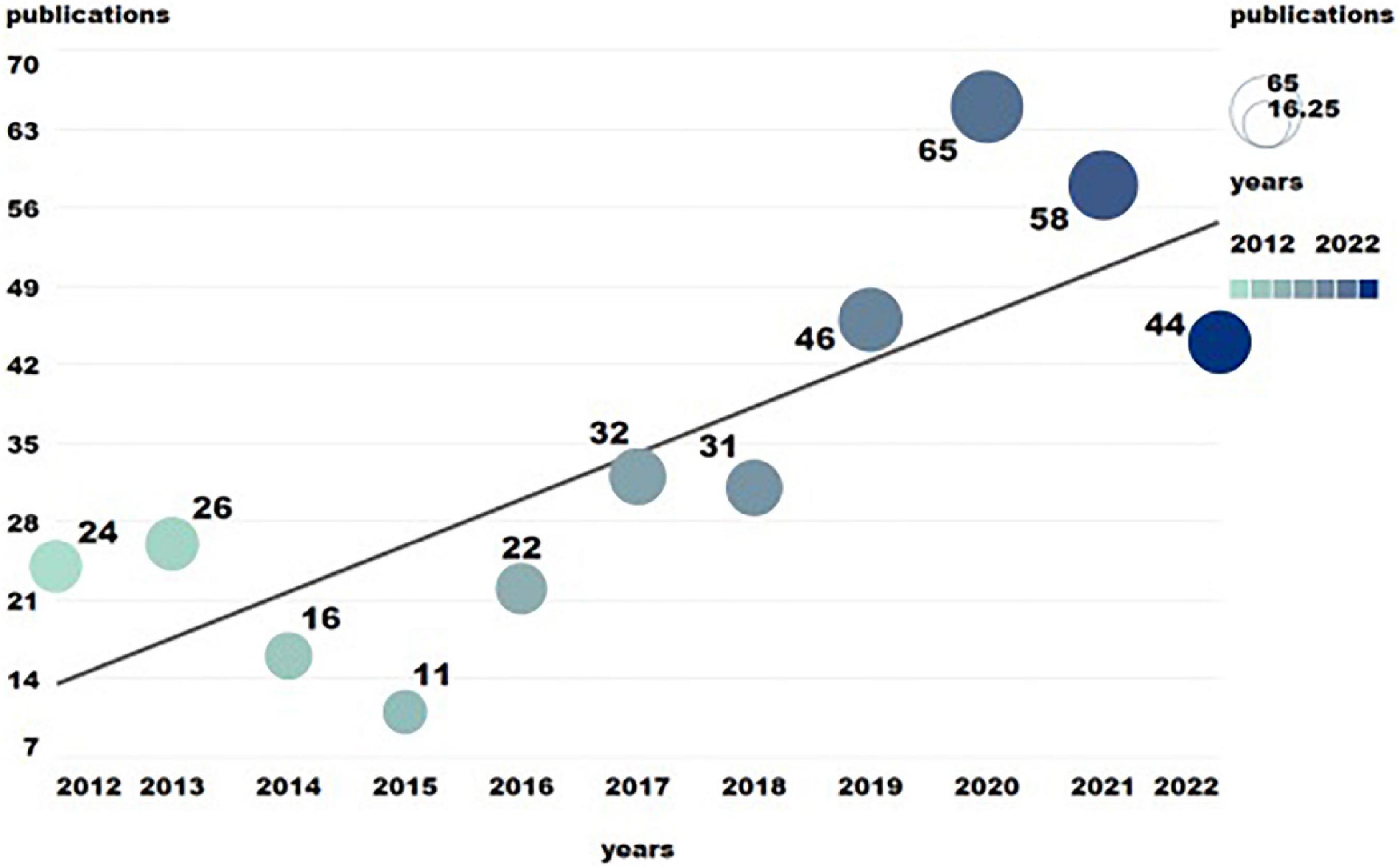
Figure 1. The annual number of publications related to traditional Chinese non-pharmacological therapies on knee osteoarthritis (KOA).
Document type analysis
There were five types of literature in total, of which, 268 “Articles” were the largest type of literature (71.4%), indicating that a large number of clinical and basic trials have been conducted in the past decade to verify the efficacy of traditional Chinese non-pharmacological therapies in the treatment of KOA. This was followed by “Review” with 82 articles, indicating that retrospective research was also valued by researchers, while 25 articles (6.5%) were of other types (Table 2).
National analysis
According to the national analysis, a total of 32 countries involved in the research of traditional Chinese non-pharmacological therapies on KOA from 2012 to 2022. China published 252 articles and was the most active country, the United States was the second (71), England (Wang et al., 2021) and South Korea (Vickers et al., 2012). Among them, China and the United States had the strongest correlation, indicating close cooperation among the regions. From the perspective of centrality, the United States ranked first (0.68), followed by Australia (0.21) and China (0.19). The top three most-cited countries were the United States (2363), China (1688), and England (1664; Table 3). Regionally, Asia and Europe were the research centers, with a clear clustering phenomenon. For example, China, Japan, South Korea, and Singapore were the major contributors to Asian research, while Spain, England, and Germany were the main drivers of European research (Figure 2).
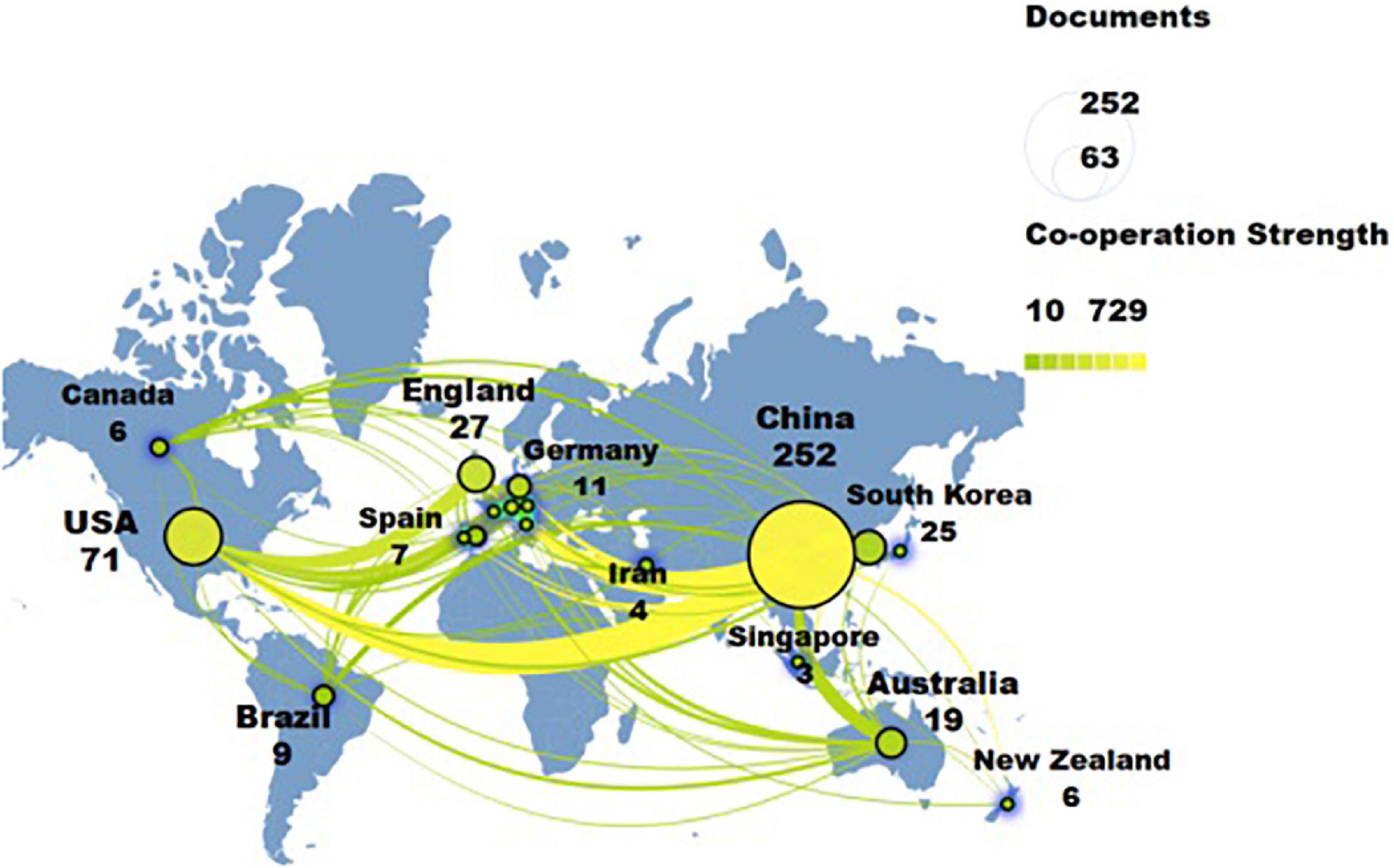
Figure 2. The collaboration network of countries researching traditional Chinese non-pharmacological therapies on knee osteoarthritis (KOA).
Institutional analysis
According to the analysis of 557 institutions participating in studies of traditional Chinese non-pharmacological therapies on KOA over the past decade, 36 institutions published more than five articles (Figure 3), with Beijing University of Chinese Medicine (Tu et al., 2021) published the most, followed by Shanghai University of Chinese Medicine (National Institute for Health and Care Excellence, 2014), and Capital Medical University (White A. et al., 2012), which noted that traditional Chinese non-pharmacological therapies helped to improve pain and restore the knee function in KOA patients (Wang M. et al., 2020; Zhang Y. et al., 2020; Tu et al., 2021), suggesting that this effect may be achieved through the changes of inflammatory cytokines TNG-α, IL-1β, and IL-13 (Shi et al., 2020), which have received more attention in recent years. In terms of centrality, Beijing University of Chinese Medicine (0.1) ranked the top one, followed by Capital Medical University (0.1), and Korea Medical College of Oriental Medicine (0.08). The top three most frequently cited universities were University of York (1314), University of Southampton (1237), and Memorial Sloan-Kettering Cancer Center (1185, Table 4). Through the close collaboration with Klee University and Charite, their study indicated that the effect of acupuncture on KOA was related to the amount and duration of acupuncture (MacPherson et al., 2013; Vickers et al., 2018), and the effect was long-lasting (MacPherson et al., 2017), suggesting that acupuncture was a recommended therapy for KOA (Vickers et al., 2012).
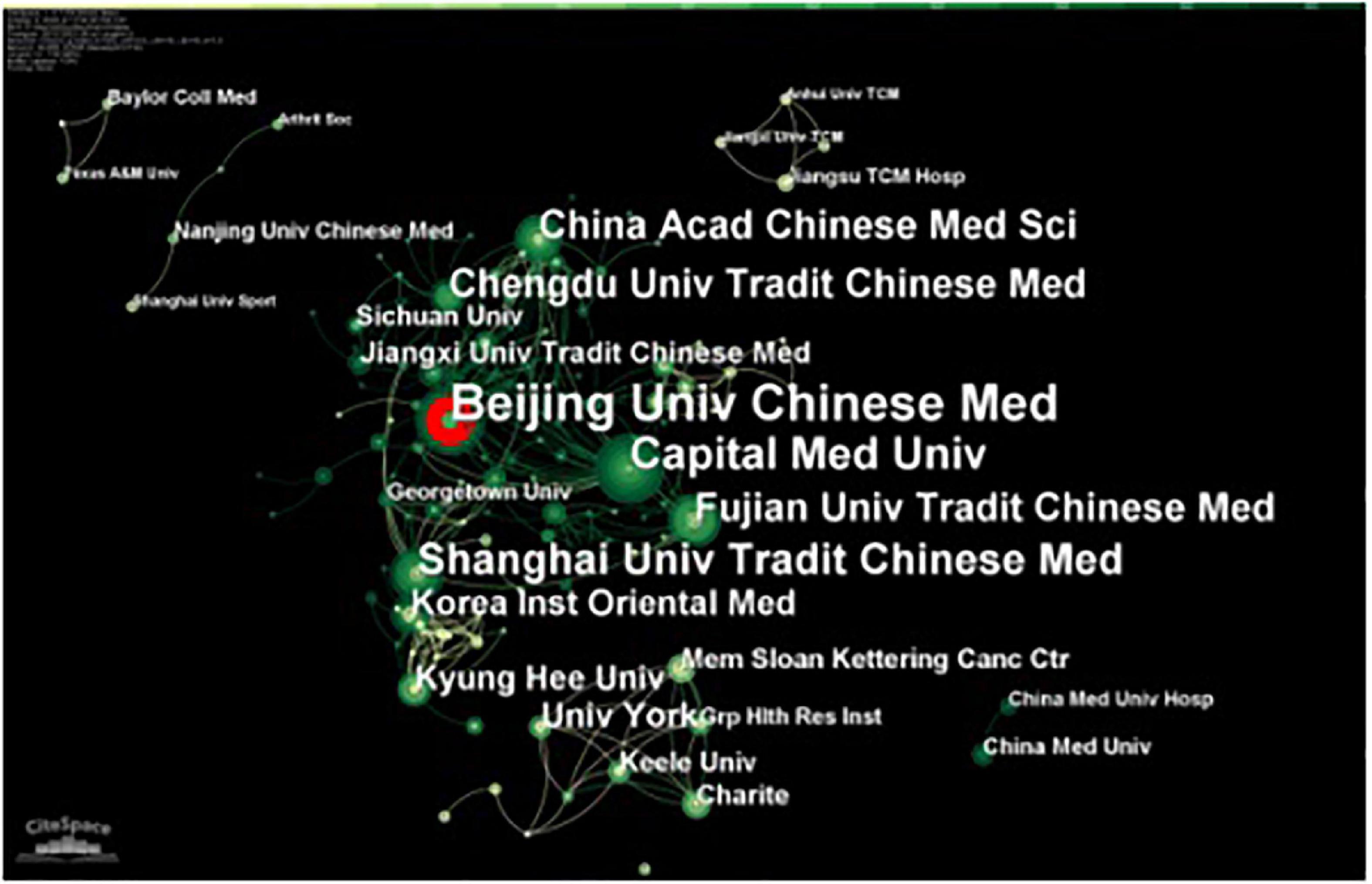
Figure 3. The collaboration map of institutions related to traditional Chinese non-pharmacological therapies on knee osteoarthritis (KOA).
Author analysis
Over the past decade, 2,021 authors participated in the study of traditional Chinese non-pharmacological therapies for KOA, among which, 27 authors have published more than five articles. The three authors with the most published literature were Cun-Zhi Liu (Li et al., 2021), Jian-Feng Tu (Li et al., 2021), and Li-Qiong Wang (Zhang X. et al., 2012), who concluded that acupuncture was an effective method by observing specific changes in the brain function in patients with KOA (Zhang N. et al., 2020). They also found that intestinal flora was a possible target (Wang et al., 2021), and improving the frequency of treatment may lead to better outcomes (Lin et al., 2020). The three authors with the highest centrality were Wang X (0.11), Li X (0.08), and Li Y (0.08). The most frequently cited author was Lewith G (1153; Table 5), who draws a negative conclusion on traditional Chinese non-pharmacological therapies, suggesting that acupuncture and Qi Gong were not particularly effective compared to controls and that patient’s confidence in the physician and treatment method had a significant effect on the outcome (Macfarlane et al., 2012; White P. et al., 2012). Macpherson H (1128) and Vickers A (1066) also had high citation frequency (Table 5). The authors with the purple outer circles indicate a high between centrality and were core researchers in the research field. The authors with the red mark represent a prominent frequency over a period of time. For example, Macpherson H, Cun-Zhi Liu, and Li-Qiong Wang were the most active authors in the last decade (Figure 4).
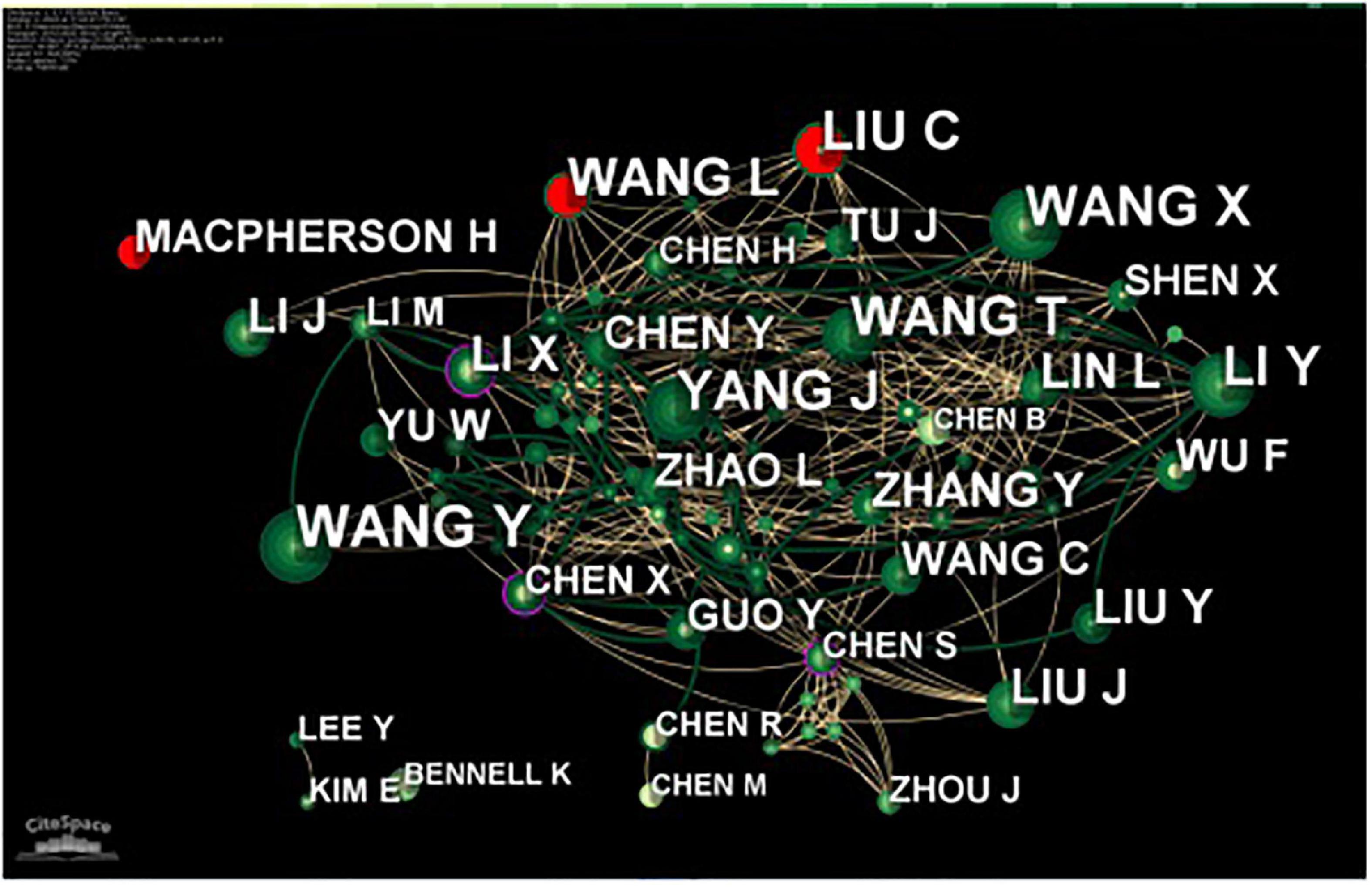
Figure 4. The collaboration map of Authors related to traditional Chinese non-pharmacological therapies on knee osteoarthritis (KOA).
Journal analysis
Journal analysis showed that a total of 2,994 journals were cited, of which 107 journals were cited more than 20 times. The most frequently cited journal in total was Osteoarthritis Cartilage (560), followed by Pain (409), and Acupuncture in Medicine (365). The top three journals in terms of centrality were Arthritis Rheumatism (0.1), Arthritis Care Research (0.08), and Complementary Therapies in Medicine (0.08). The top three journals in terms of number of publications were Evidence-Based Complementary and Alternative Medicine (Wang et al., 2016), Medicine (Choi et al., 2017), and Trials (Vickers et al., 2012; Table 6). Journals with purple outer rings indicate high between centrality, publish important literature and were key hubs for the entire network. Journals marked in red indicate a high highlighting frequency during a given time period. For example, clinical Journal of Pain, Journal of Pain Research, and Medicine were the journals that have been highlighted most frequently in the last 3 years (Figure 5).
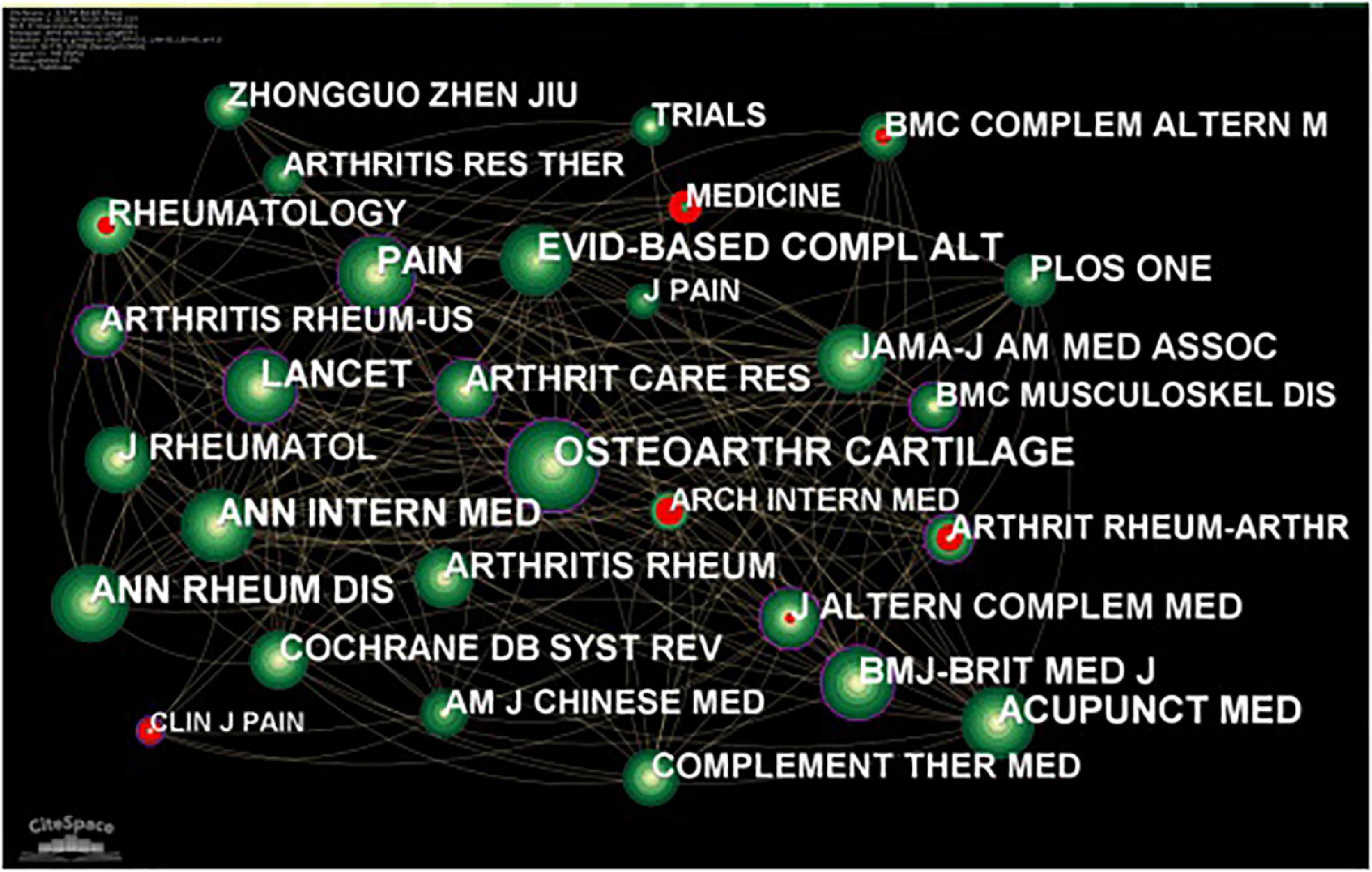
Figure 5. The co-cited journal related to traditional Chinese non-pharmacological therapies on knee osteoarthritis (KOA).
Reference analysis
We screened the most representative literature about traditional Chinese non-pharmacological therapies in the treatment of KOA from 2012 to 2022. The yellow line represents literature from 2012 to 2015, and the representative cluster labels were “alternative therapy,” “group acupuncture” and “exercise prescription,” and the green line represents the literature from 2016 to 2022 with the representative cluster labels of “knee osteoarthritis,” “massage analgesia,” “warm acupuncture,” and “non-specific efficacy” (Figure 6). We found that the most frequently cited literature was the 2014 guidelines issued by the International Society for Osteoarthritis Research (OARSI), which listed Tai Chi as a core treatment for KOA (McAlindon et al., 2014). In addition, the American College of Rheumatology guidelines also list Tai Chi as a recommended treatment for KOA (Hochberg et al., 2012). These two guidelines have received extensive attention from researchers, and their recommendations have been adopted in a number of studies (Table 7). Six of the first 10 cited articles discussed the clinical effects of acupuncture on KOA, and the use of which has received a lot attention from researchers, particularly the placebo effect of acupuncture. A randomized controlled clinical trial published by Hinman RS in JAMA showed that acupuncture was no more beneficial than sham acupuncture in treating chronic knee pain (Hinman et al., 2014).
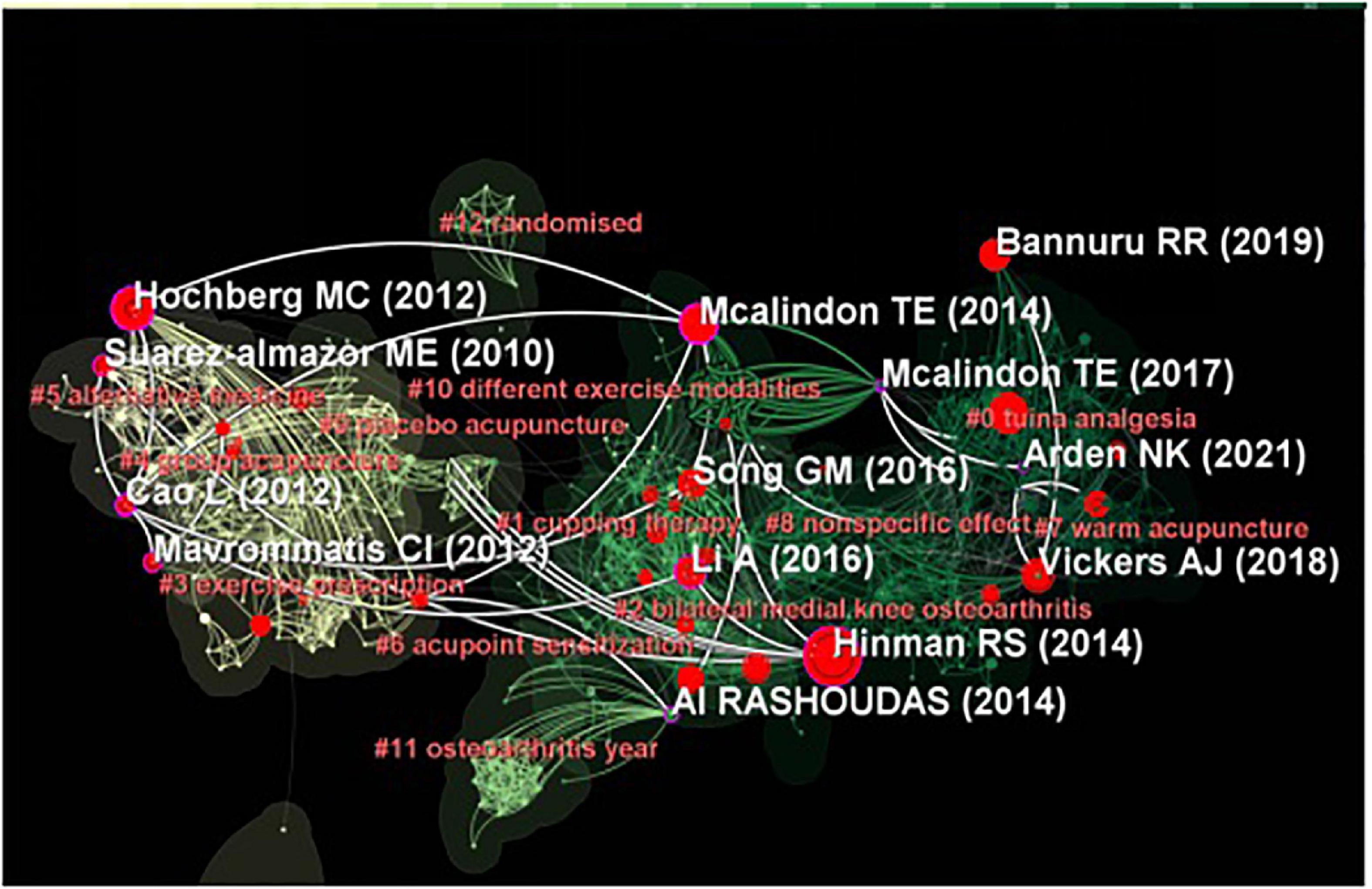
Figure 6. The network and cluster map of co-cited references related to traditional Chinese non-pharmacological therapies on knee osteoarthritis (KOA).
Keyword analysis
We analyzed literature related to traditional Chinese non-pharmacological therapies on KOA in the past decade and summarized the keywords with the highest co-occurrence frequency and centrality (Table 8). The co-occurrence frequency indicates the frequency of the keywords, and the centrality represents the degree to which keywords are noticed. A node with a centrality greater than 0.1 indicates that the node has greater influence in the study. “Knee osteoarthritis” had the highest co-occurrence frequency (211), “adjunctive therapy” (172) and “pain” (160) were three keywords with the highest co-occurrence. The top three keywords in centrality were acupuncture (0.25), chronic pain (0.19), and alternative medicine (0.18). Figure 7 shows highlighted keywords with red nodes, representing great changes in co-occurrence frequency in a certain period of time and are used to find keywords that are decreasing or increasing. We found that “quality of life,” “older adult,” and “manual therapy” were the keywords that suddenly dominated the most during the period 2020–2022.
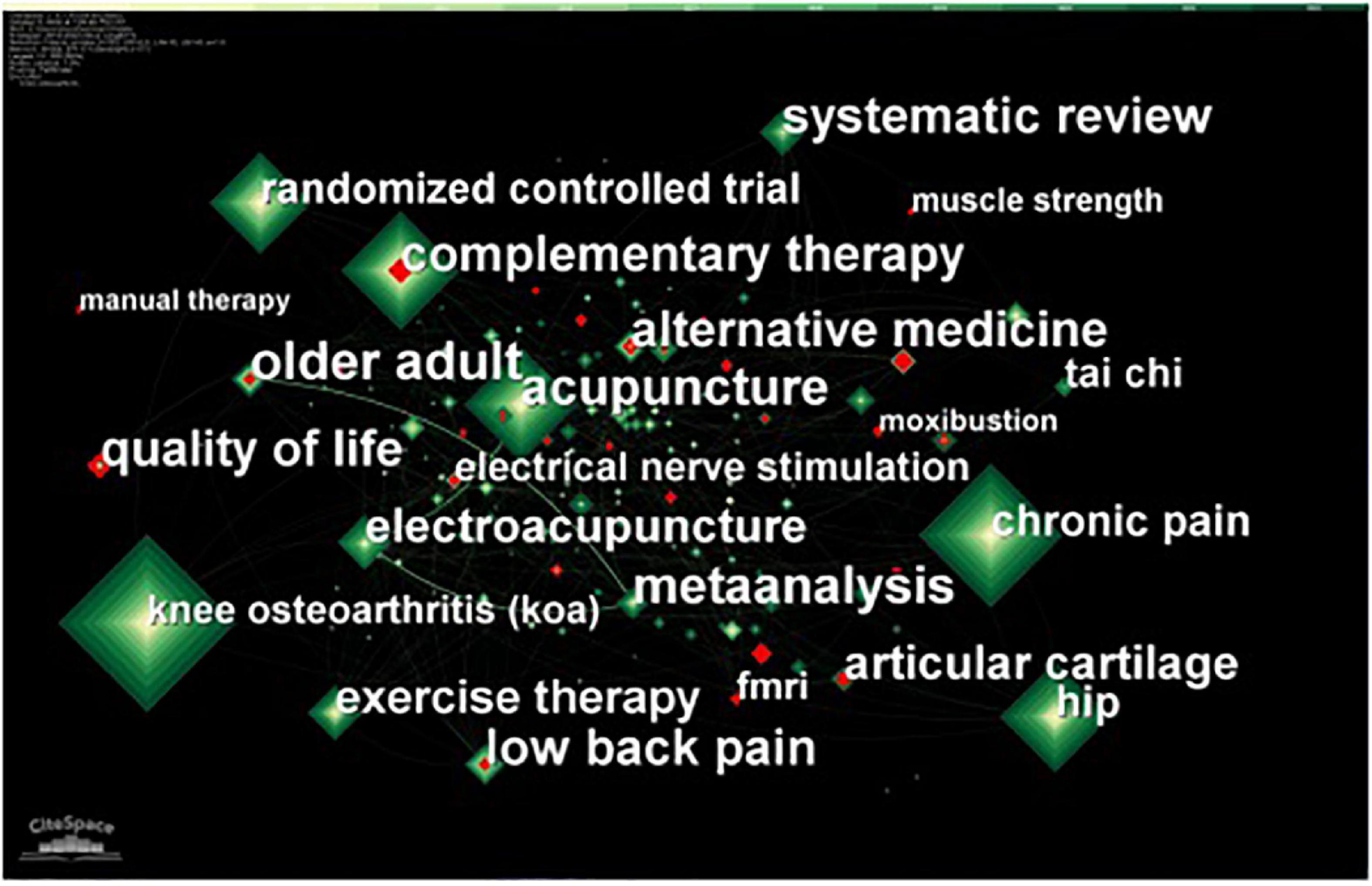
Figure 7. The network of co-occurrence keywords related to traditional Chinese non-pharmacological therapies on knee osteoarthritis (KOA).
Figure 8 shows the keyword change and keyword clustering over time from 2012 to 2022. We found that the traditional Chinese non-pharmacological therapies such as “Tai Chi,” “Qi Gong,” “electro-acupuncture,” and “auricular acupuncture” will always be high-frequency keywords, and the emotion, inflammation and evaluation scales of KOA patients will also have higher co-occurrence frequency. Among the first 10 keyword clusters, “chronic pain” was the largest cluster with a total of 67 members.
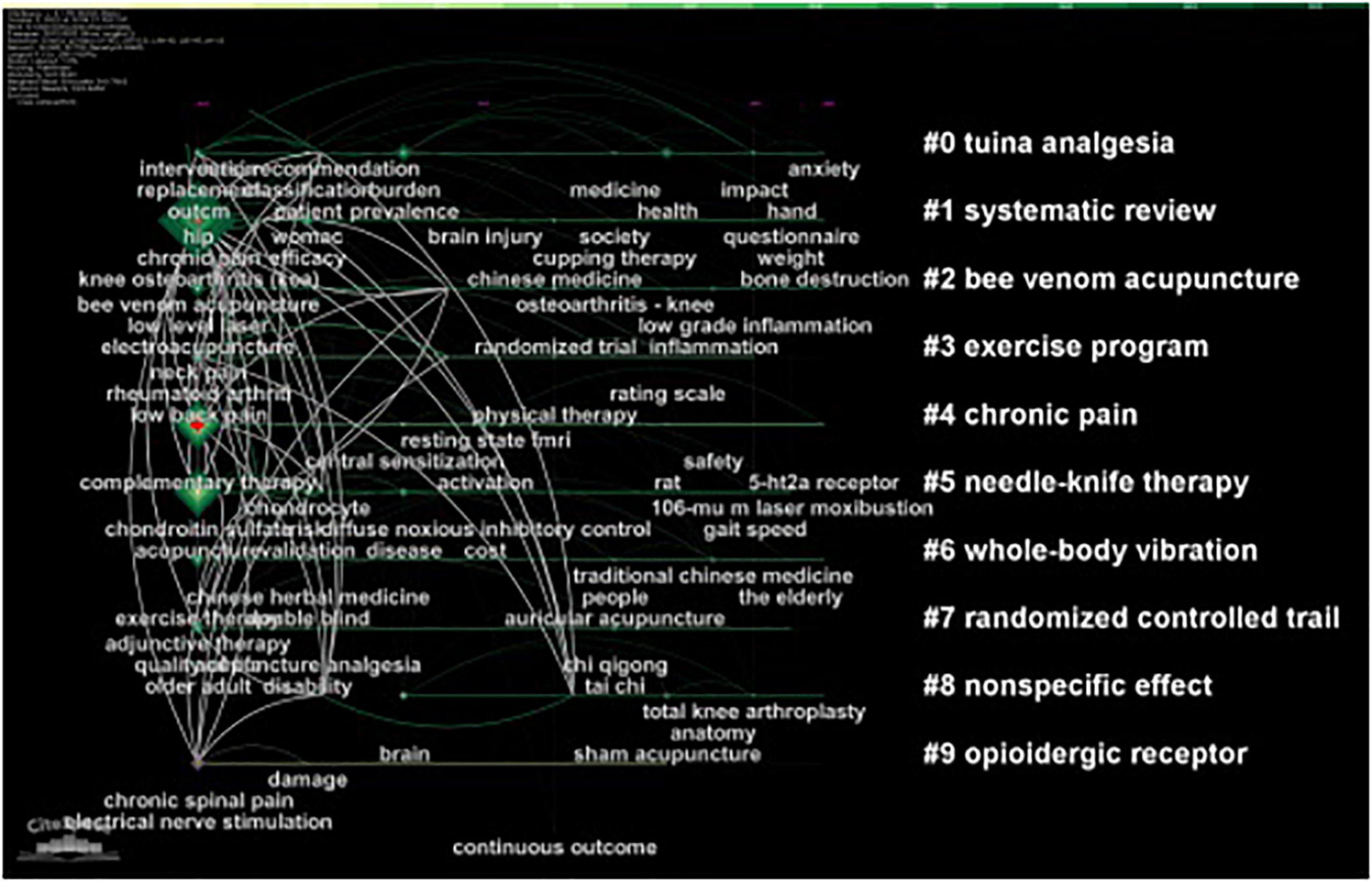
Figure 8. The timeline map of co-occurrence keywords related to traditional Chinese non-pharmacological therapies on knee osteoarthritis (KOA).
Analysis of therapies, acupoints, and evaluation index
We found that many traditional Chinese non-pharmacological therapies such as acupuncture and moxibustion involve the use of acupoints. In order to understand the use of acupoints in the treatment of KOA, we used VOSviewer and SCImago Graphica with co-occurrence frequency as screening condition. The most commonly used acupoints for treating KOA were analyzed. In addition, for other traditional Chinese non-pharmacological therapies, we analyzed the use frequency and corresponding evaluation indexes in the same way, hoping to provide ideas and references for researchers and clinicians.
The results showed that a total of 22 Chinese non-pharmacological interventions were used to treat KOA, and 16 interventions were co-occurring more than five times as often (Figure 9). A total of 49 acupoints have been mentioned in the article, 17 of which had a co-occurrence frequency of more than three times (Figure 10), and a total of 112 evaluation indexes were mentioned. Of these, 19 evaluation indicators had a co-occurrence frequency of more than five times (Figure 11).
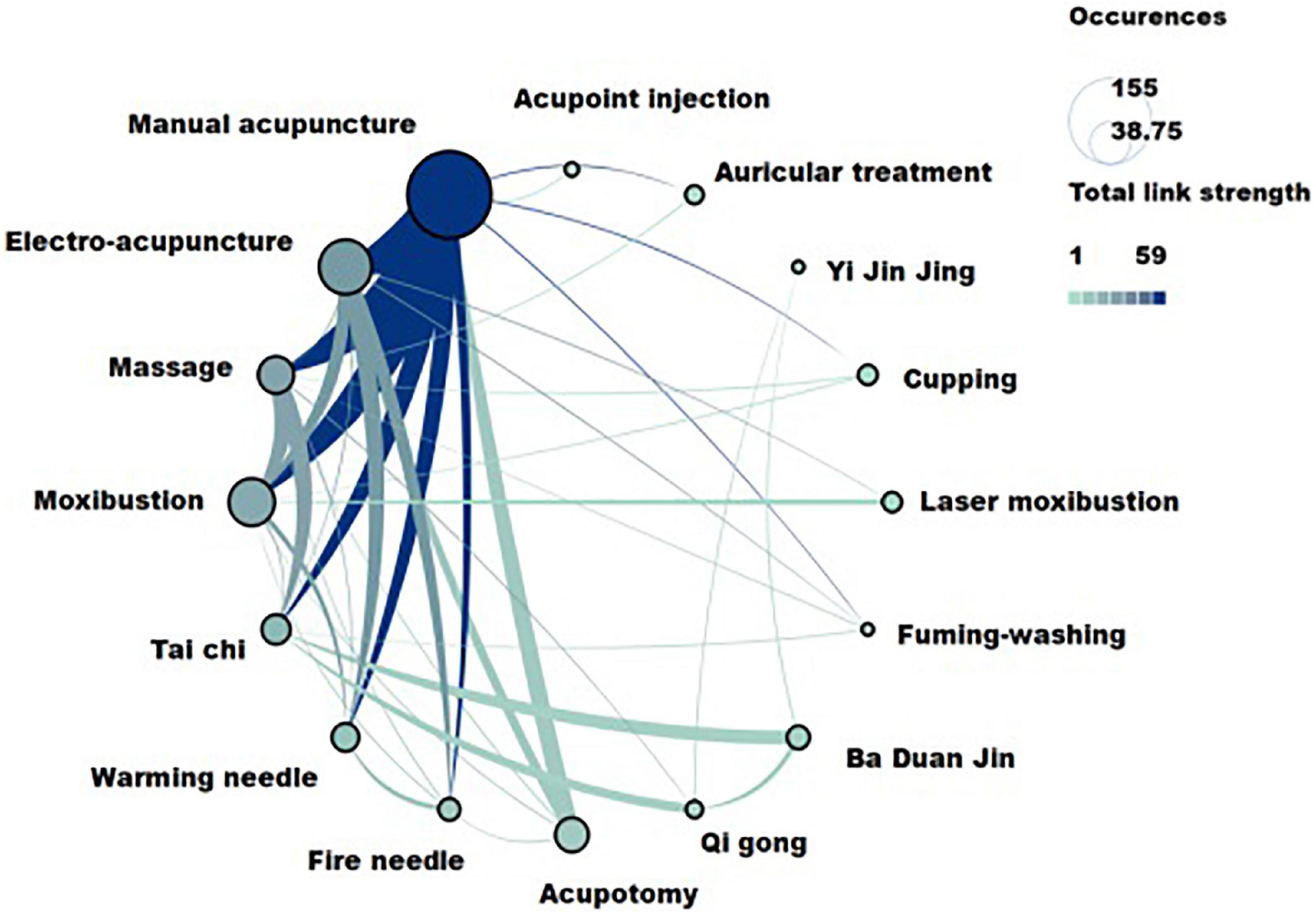
Figure 9. The therapies with co-occurrence frequency greater than five related to traditional Chinese non-pharmacological therapies on knee osteoarthritis (KOA).
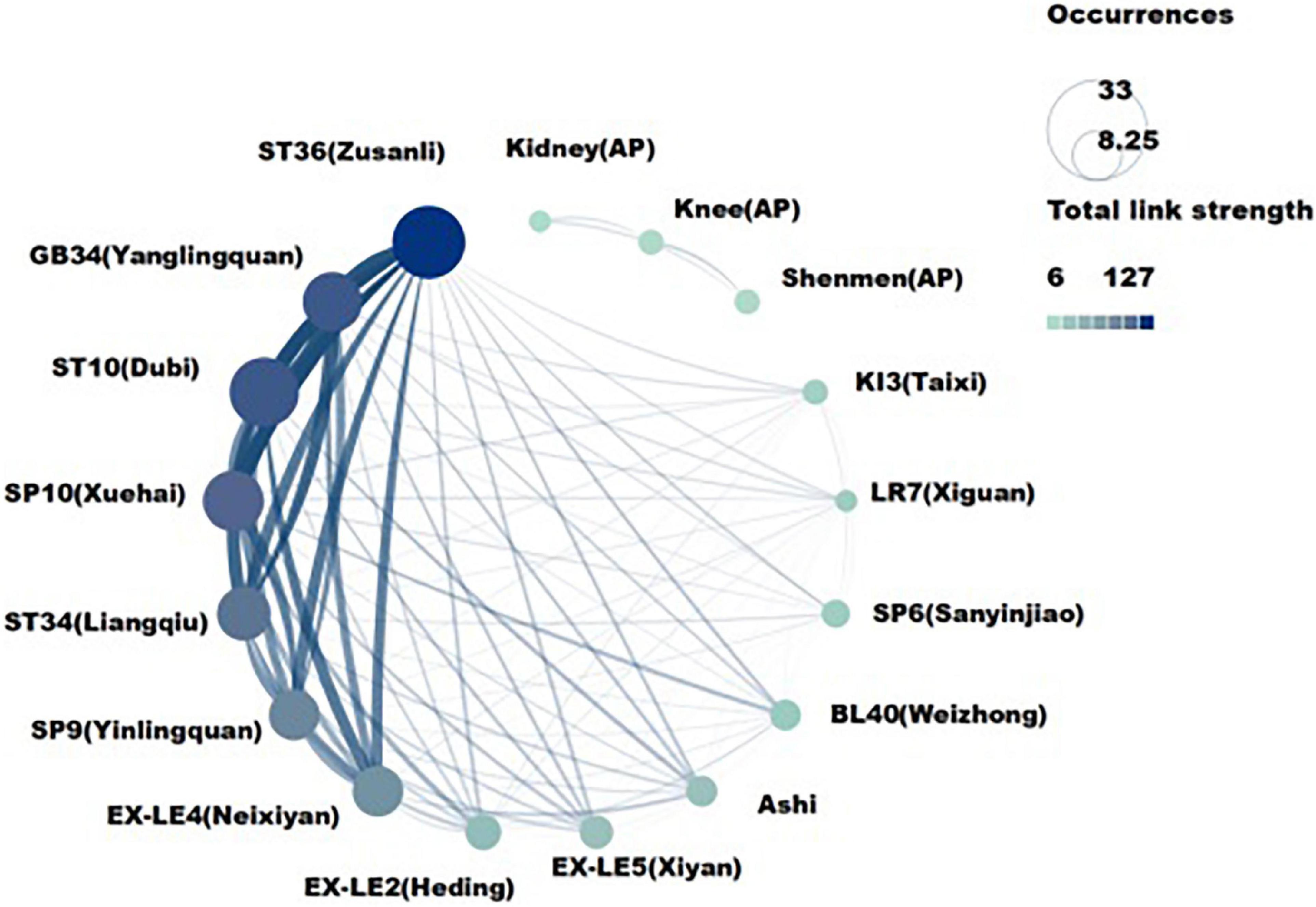
Figure 10. The acupoints with co-occurrence frequency greater than five related to traditional Chinese non-pharmacological therapies on knee osteoarthritis (KOA).
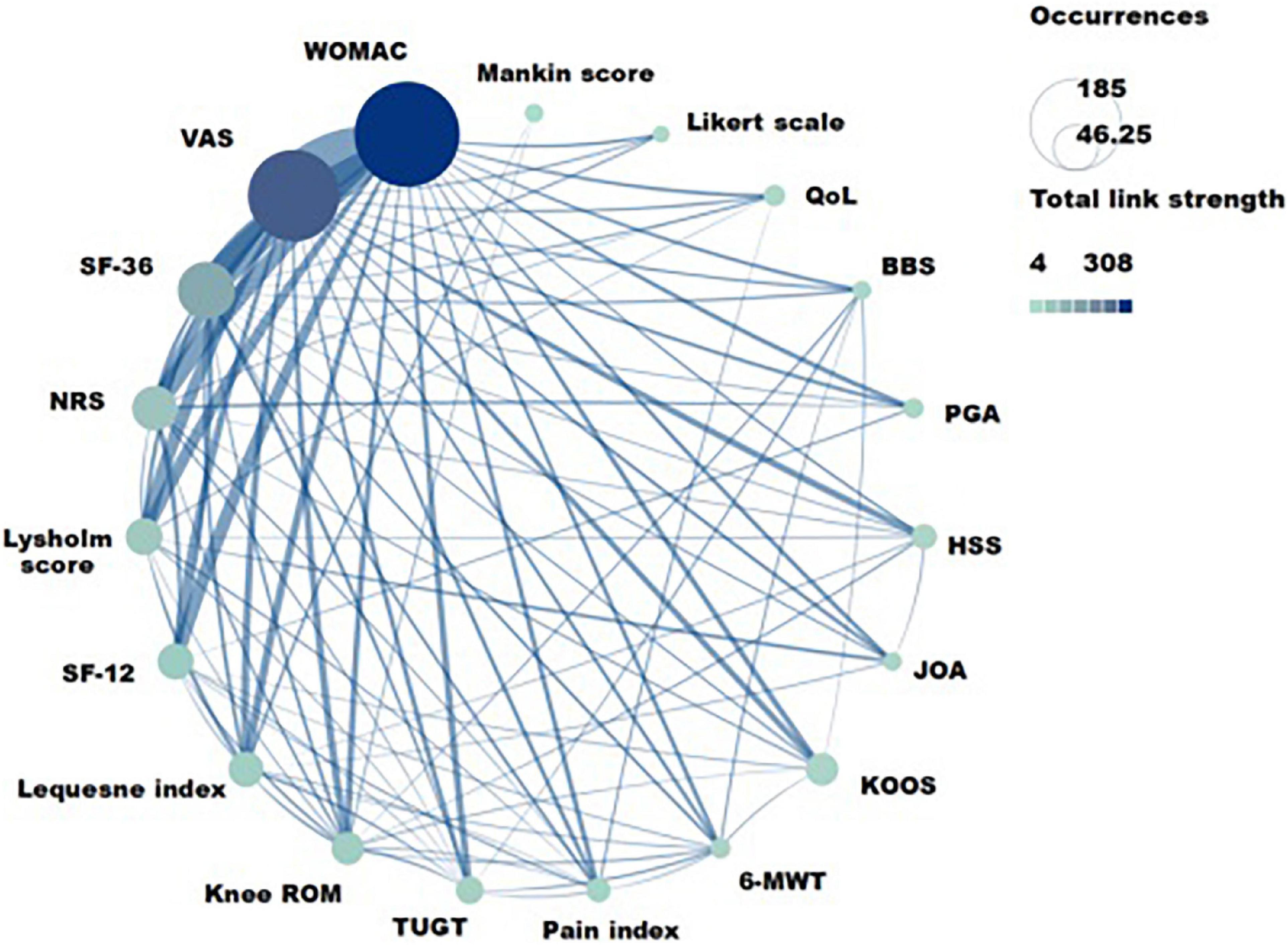
Figure 11. The evaluation indexes with co-occurrence frequency greater than five related to traditional Chinese non-pharmacological therapies on knee osteoarthritis (KOA). WOMAC, The western Ontario and McMaster universities osteoarthritis index; VAS, Pain visual analog scale; NRS, Numeric rating scale; Kee ROM, Knee range of motion test; TUGT, Timed up and go test; 6-MWT, 6-Minute walk test; KOOS, The knee injury and osteoarthritis score; JOA, Japanese Orthopedic Association knee score; HSS, Hospital for special surgery knee score; PGA, Patient Global Assessment; BBS, Berg balance scale; QoL, Qualiy of life.
The three most frequently used acupoints were ST36 (Zusanli), ST10 (Dubi), and GB34 (Yanglingquan). The three most widely used intervention methods were manual acupuncture, electro-acupuncture, and moxibustion, and the three most widely used evaluation indicators were WOMAC, VAS, and SF-36 (Table 9).
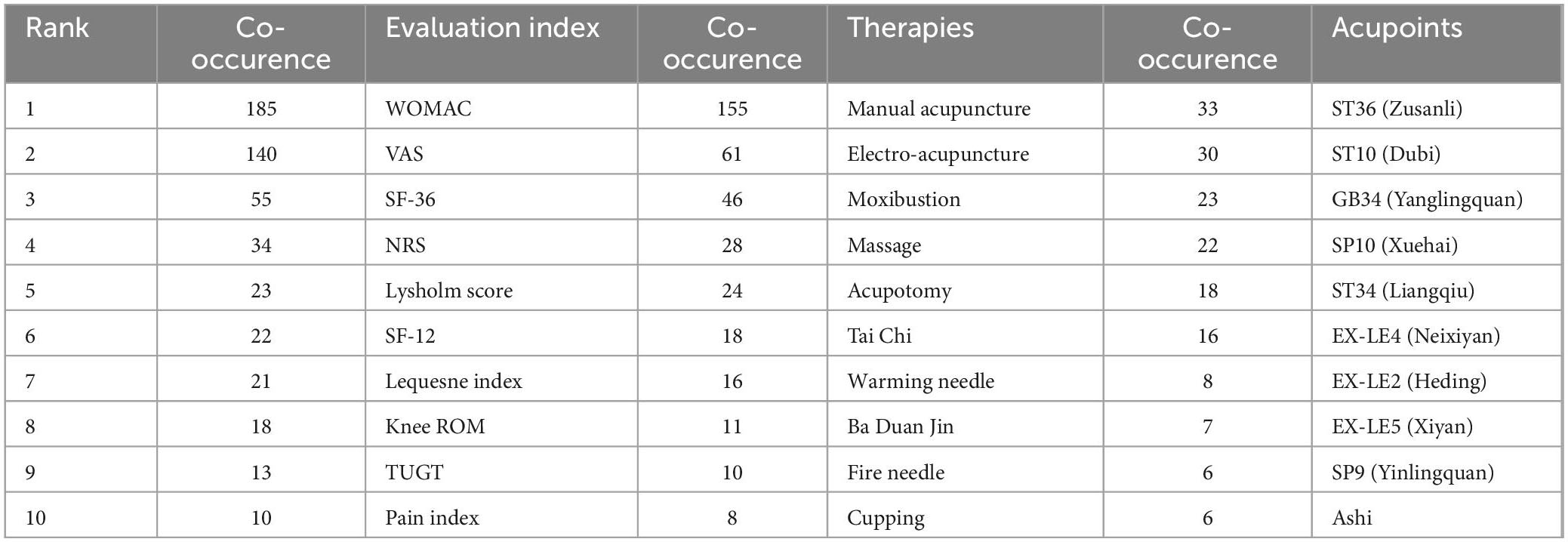
Table 9. Top 10 co-occurence indexes, therapies, and acupoints related to Chinese non-pharmacological therapy on KOA.
Discussion
This study aims to describe the global participation and research trends of traditional Chinese therapies in the treatment of KOA. traditional Chinese non-pharmacological therapies, the benefits of which were gradually being recognized globally, may be a potential treatment for KOA. As the birthplace of traditional Chinese medicine culture, China has a large number of researchers participating in this field. It should be noted that despite the fact that Chinese scientists published the most academic findings, academic publications had little effect, which may be related to the rapid increase in the number of literature in recent years and the lack of domestic academic cooperation. South Korea and Japan were influenced by traditional Chinese medicine (TCM) since the Tang dynasty (Yu et al., 2017). Korea Institute of Oriental Medicine and Kyung Hee University as representative research institutions have made active exploration on the treatment of KOA (Choi et al., 2017, 2021). Western developed countries were also inclined to TCM which has been incorporated into regulations in some countries (Xue et al., 2009; Luo et al., 2018). The International Society for Osteoarthritis Research (OARSI) recommends that acupuncture should be added to the treatment of knee osteoarthritis (Bannuru et al., 2019). National legislation and the introduction of international guidelines has promoted the research in western countries to some extent.
Acupuncture was the most widely used Chinese non-pharmacologic therapy, among which ST36 (Zusanli) was the most frequently used acupoint, while most other acupoints were concentrated near the knee joint, reflecting the distribution of pain sensitivity (Luo et al., 2018). A lot of studies have demonstrated that acupuncture can help relieve pain in patients with KOA, promote recovery and reduce the burden on patients and society (Wang et al., 2016; Ma et al., 2017). Traditional Chinese non-pharmacological therapies such as moxibustion and Tai Chi have also shown high credibility (Liu et al., 2017; Xiao et al., 2020; Guo et al., 2022). The International Society for Osteoarthritis (OARSI) even recommends Tai Chi for all knee osteoarthritis patients because of its satisfactory performance in relieving pain and improving proprioception of knee joints (Woods et al., 2017; Liu et al., 2019; Hu et al., 2020). For the efficacy of traditional Chinese non-pharmacological therapies, researchers generally used WOMAC to evaluate knee joint dysfunction because of its objectivity, effectiveness, and sensitivity (Wolfe, 1999; Lingard et al., 2001; Da et al., 2021). The quality of life and emotion of elderly patients have been paid much more attention in recent years, and the majority of them were female, accounting for about 65% of KOA patients, with an average age of about 65 years (Li et al., 2018; Wang Q. et al., 2020; Zhao et al., 2021), which may be related to post-menopausal osteoporosis (Zhang Y. et al., 2012; Qin et al., 2013). Notably, certain randomized controlled clinical trials have revealed subpar evidence of traditional Chinese non-pharmacological therapy’s efficacy against KOA (Li et al., 2017; Lam et al., 2021), and the National Institute for Health and Care Excellence (NICE) recommendations even advise against the use of acupuncture for osteoarthritis (Conaghan et al., 2008). Therefore, more randomized controlled trials with strict design are needed to confirm the impact of traditional Chinese non-pharmacological therapies on KOA.
Limitations
Citespace software can not directly identify literature from PubMed database, we need to convert the PubMed data into WoS format, which may lead to identification bias of some data, we have tried our best to correct this situation, but there may still be minor deviations.
Conclusion
Chinese non-pharmacological therapies has shown certain advantages in the treatment of KOA and has received wide attention. Relieving pain and restoring quality of life of KOA patients has been a common concern of researchers all over the world. At present, the development of Chinese non-pharmacological therapies was unbalanced with acupuncture accounting for a relatively high proportion, and the application of tuina, moxibustion, and other therapies in KOA needs to be further explored. In addition, how to exclude the possible placebo effect in response to international doubts is also an urgent problem for the future.
Author contributions
XT and XZ contributed to the concept and design of the research. MZ, YL, and SJ conducted the data collection and analysis. SZ and YW wrote the first draft of the manuscript. All authors contributed to the revision of the manuscript, read, and approved the submitted version.
Funding
This study was supported by Yunnan Provincial Department of Science and Technology Biomedical Key Project (Grant No. 202102AA100016) and Yunnan Basic Research Traditional Chinese Medicine Joint Special Project (Grant Nos. 202001AZ070001-002 and 202101AZ070001-059).
Conflict of interest
The authors declare that the research was conducted in the absence of any commercial or financial relationships that could be construed as a potential conflict of interest.
Publisher’s note
All claims expressed in this article are solely those of the authors and do not necessarily represent those of their affiliated organizations, or those of the publisher, the editors and the reviewers. Any product that may be evaluated in this article, or claim that may be made by its manufacturer, is not guaranteed or endorsed by the publisher.
References
Bannuru, R., Osani, M., Vaysbrot, E., Arden, N., Bennell, K., Bierma-Zeinstra, S., et al. (2019). Oarsi guidelines for the non-surgical management of knee, hip, and polyarticular osteoarthritis. Osteoarthritis Cartilage 27, 1578–1589. doi: 10.1016/j.joca.2019.06.011
Chen, C., and Song, M. (2019). Visualizing a field of research: A methodology of systematic scientometric reviews. PLoS One 14:e223994. doi: 10.1371/journal.pone.0223994
Chen, H., Wu, J., Wang, Z., Wu, Y., Wu, T., Wu, Y., et al. (2021). Trends and patterns of knee osteoarthritis in china: A longitudinal study of 17.7 million adults from 2008 to 2017. Int. J. Environ. Res. Public Health 18:8864. doi: 10.3390/ijerph18168864
Choi, T., Ang, L., Ku, B., Jun, J., and Lee, M. (2021). Evidence map of cupping therapy. J. Clin. Med. 10:1750. doi: 10.3390/jcm10081750
Choi, T., Lee, M., Kim, J., and Zaslawski, C. (2017). Moxibustion for the treatment of osteoarthritis: An updated systematic review and meta-analysis. Maturitas 100, 33–48. doi: 10.1016/j.maturitas.2017.03.314
Conaghan, P., Dickson, J., and Grant, R. (2008). Care and management of osteoarthritis in adults: Summary of nice guidance. BMJ 336, 502–503. doi: 10.1136/bmj.39490.608009.AD
Corbett, M. S., Rice, S. J. C., Madurasinghe, V., Slack, R., Fayter, D. A., Harden, M., et al. (2013). Acupuncture and other physical treatments for the relief of pain due to osteoarthritis of the knee: Network meta-analysis. Osteoarth. Cartil. 21, 1290–1298. doi: 10.1016/j.joca.2013.05.007
Da, C., Saadat, P., Basciani, R., Agarwal, A., Johnston, B., and Juni, P. (2021). Visual analogue scale has higher assay sensitivity than womac pain in detecting between-group differences in treatment effects: A meta-epidemiological study. Osteoarthritis Cartilage 29, 304–312. doi: 10.1016/j.joca.2020.10.004
Deshpande, B., Katz, J., Solomon, D., Yelin, E., Hunter, D., Messier, S., et al. (2016). Number of persons with symptomatic knee osteoarthritis in the us: Impact of race and ethnicity, age, sex, and obesity. Arthritis Care Res. 68, 1743–1750. doi: 10.1002/acr.22897
Gang, B., Shin, J., Lee, J., Lee, Y., Cho, H., Kim, R., et al. (2020). Association between acupuncture and knee surgery for osteoarthritis: A Korean, nationwide, matched, retrospective cohort study. Front. Med 7:524628. doi: 10.3389/fmed.2020.524628
Guo, D., Ma, S., Zhao, Y., Dong, J., Guo, B., and Li, X. (2022). Self-administered acupressure and exercise for patients with osteoarthritis: A randomized controlled trial. Clin. Rehabil. 36, 350–358. doi: 10.1177/02692155211049155
Hinman, R., McCrory, P., Pirotta, M., Relf, I., Forbes, A., Crossley, K., et al. (2014). Acupuncture for chronic knee pain a randomized clinical trial. JAMA 312, 1313–1322. doi: 10.1001/jama.2014.12660
Ho, K., Pong, G., Poon, Q., Kwok, J., Chau, W., and Ong, M. (2021). A community-centric multi-disciplinary education program with the 8-section brocade tai chi therapy for patients with osteoarthritis of the knee – a pilot study. BMC Complement. Med. Ther. 21:297. doi: 10.1186/s12906-021-03480-2
Hochberg, M., Altman, R., April, K., Benkhalti, M., Guyatt, G., McGowan, J., et al. (2012). American college of rheumatology 2012 recommendations for the use of nonpharmacologic and pharmacologic therapies in osteoarthritis of the hand, hip, and knee. Arthritis Care Res. 64, 465–474. doi: 10.1002/acr.21596
Hu, X., Lai, Z., and Wang, L. (2020). Effects of taichi exercise on knee and ankle proprioception among individuals with knee osteoarthritis. Res. Sports Med. 28, 268–278. doi: 10.1080/15438627.2019.1663520
Huang, B. (2019). The cpc central committee and the state council issued the opinions on promoting the inheritance and innovation of traditional chinese medicine. J. Tradit. Chin. Med. Manage. 27:191. doi: 10.16690/j.cnki.1007-9203.2019.21.089
Krishnamurthy, A., Lang, A., Pangarkar, S., Edison, J., Cody, J., and Sall, J. (2021). Synopsis of the 2020 us department of veterans affairs/us department of defense clinical practice guideline: The non-surgical management of hip and knee osteoarthritis. Mayo Clin. Proc. 96, 2435–2447. doi: 10.1016/j.mayocp.2021.03.017
Lam, W., Au, K., Qin, Z., Wu, F., Chong, C., Jiang, F., et al. (2021). Superficial needling acupuncture vs sham acupuncture for knee osteoarthritis: A randomized controlled trial. Am. J. Med. 134:1286. doi: 10.1016/j.amjmed.2021.05.002
Li, J., Guo, W., Sun, Z., Huang, Q., Lee, E., Wang, Y., et al. (2017). Cupping therapy for treating knee osteoarthritis: The evidence from systematic review and meta-analysis. Complement. Ther. Clin. Pract. 28, 152–160. doi: 10.1016/j.ctcp.2017.06.003
Li, L., Harris, R., Tsodikov, A., Struble, L., and Murphy, S. (2018). Self-acupressure for older adults with symptomatic knee osteoarthritis: A randomized controlled trial. Arthritis Care Res. 70, 221–229. doi: 10.1002/acr.23262
Li, W., Weng, L., Xiang, Q., and Fan, T. (2021). Trends in research on traditional chinese health exercises for improving cognitive function: A bibliometric analysis of the literature from 2001 to 2020. Front. Public Health 9:794836. doi: 10.3389/fpubh.2021.794836
Li, X., Yin, Z., Ling, F., Zheng, Q., Li, X., Qi, W., et al. (2022). The application of acupuncture in cardiopathy: A bibliometric analysis based on web of science across ten recent years. Front. Cardiovasc. Med. 9:920491. doi: 10.3389/fcvm.2022.920491
Lin, L., Tu, J., Wang, L., Yang, J., Shi, G., Li, J., et al. (2020). Acupuncture of different treatment frequencies in knee osteoarthritis: A pilot randomised controlled trial. Pain 161, 2532–2538. doi: 10.1097/j.pain.0000000000001940
Lingard, E., Katz, J., Wright, R., Wright, E., and Sledge, C. (2001). Validity and responsiveness of the knee society clinical rating system in comparison with the sf-36 and womac. J. Bone Joint Surg. Am. 83, 1856–1864. doi: 10.2106/00004623-200112000-00014
Liu, D., Wu, Y., Li, C., Ma, X., Wang, M., Zhang, Y., et al. (2017). Effect of warming moxibustion on expression of mmp1/13 by jnk pathway of cartilage cells in rabbit knee osteoarthritis. Int. J. Clin. Exp. Med. 10, 10433–10442.
Liu, J., Chen, L., Chen, X., Hu, K., Tu, Y., Lin, M., et al. (2019). Modulatory effects of different exercise modalities on the functional connectivity of the periaqueductal grey and ventral tegmental area in patients with knee osteoarthritis: A randomised multimodal magnetic resonance imaging study. Br. J. Anaesth. 123, 506–518. doi: 10.1016/j.bja.2019.06.017
Lu, J., Huang, L., Wu, X., Fu, W., and Liu, Y. (2017). Effect of tai ji quan training on self-reported sleep quality in elderly chinese women with knee osteoarthritis: A randomized controlled trail. Sleep Med. 33, 70–75. doi: 10.1016/j.sleep.2016.12.024
Luo, Y., Zhou, Y., Zhong, X., Zhao, L., Zheng, Q., Zheng, H., et al. (2018). Observation of pain-sensitive points in patients with knee osteoarthritis: A pilot study. Eur. J. Integr. Med. 21, 77–81. doi: 10.1016/j.eujim.2018.06.006
Ma, S., Xie, Z., Guo, Y., Yu, J., Lu, J., Zhang, W., et al. (2017). Effect of acupotomy on fak-pi3k signaling pathways in koa rabbit articular cartilages. Evid. Based Complement. Alternat. Med. 2017:4535326. doi: 10.1155/2017/4535326
Macfarlane, G., Paudyal, P., Doherty, M., Ernst, E., Lewith, G., MacPherson, H., et al. (2012). A systematic review of evidence for the effectiveness of practitioner-based complementary and alternative therapies in the management of rheumatic diseases: Osteoarthritis. Rheumatology 51, 2224–2233. doi: 10.1093/rheumatology/kes200
MacPherson, H., Maschino, A., Lewith, G., Foster, N., Witt, C., and Vickers, A. (2013). Characteristics of acupuncture treatment associated with outcome: An individual patient meta-analysis of 17,922 patients with chronic pain in randomised controlled trials. PLoS One 8:e7743810. doi: 10.1371/journal.pone.0077438
MacPherson, H., Vertosick, E., Foster, N., Lewith, G., Linde, K., Sherman, K., et al. (2017). The persistence of the effects of acupuncture after a course of treatment: A meta-analysis of patients with chronic pain. Pain 158, 784–793. doi: 10.1097/j.pain.0000000000000747
MacPherson, H., Vertosick, E., Lewith, G., Linde, K., Sherman, K. J., Witt, C. M., et al. (2014). Influence of control group on effect size in trials of acupuncture for chronic pain: A secondary analysis of an individual patient data meta-analysis. PLoS One 9:e937394. doi: 10.1371/journal.pone.0093739
Manyanga, T., Froese, M., Zarychanski, R., Abou-Setta, A., Friesen, C., Tennenhouse, M., et al. (2014). Pain management with acupuncture in osteoarthritis: A systematic review and meta-analysis. Bmc Compl. Altern. Med. 14:312. doi: 10.1186/1472-6882-14-312
McAlindon, T., Bannuru, R., Sullivan, M., Arden, N., Berenbaum, F., Bierma-Zeinstra, S., et al. (2014). Oarsi guidelines for the non-surgical management of knee osteoarthritis. Osteoarthritis Cartilage 22, 363–388. doi: 10.1016/j.joca.2014.01.003
Nahin, R. L., Boineau, R., Khalsa, P. S., Stussman, B. J., and Weber, W. J. (2016). Evidence-based evaluation of complementary health approaches for pain management in the United States. Mayo Clin Proc. 91, 1292–1306. doi: 10.1016/j.mayocp.2016.06.007
National Institute for Health and Care Excellence (2014). Osteoarthritis: Care and management in adults. London: National Institute for Health and Care Excellence (UK).
Qin, Y., He, J., Xia, L., Guo, H., and He, C. (2013). Effects of electro-acupuncture on oestrogen levels, body weight, articular cartilage histology and mmp-13 expression in ovariectomised rabbits. Acupunct. Med. 31, 214–221. doi: 10.1136/acupmed-2012-010289
Shi, G., Tu, J., Wang, T., Yang, J., Wang, L., Lin, L., et al. (2020). Effect of electro-acupuncture (ea) and manual acupuncture (ma) on markers of inflammation in knee osteoarthritis. J. Pain Res. 13, 2171–2179. doi: 10.2147/JPR.S256950
Sun, F., Wang, J., and Wen, X. (2012). Acupuncture in stroke rehabilitation: Literature retrieval based on international databases. Neural Regen. Res. 7, 1192–1199. doi: 10.3969/j.issn.1673-5374.2012.15.011
Tu, J., Yang, J., Shi, G., Yu, Z., Li, J., Lin, L., et al. (2021). Efficacy of intensive acupuncture versus sham acupuncture in knee osteoarthritis: A randomized controlled trial. Arthritis Rheumatol. 73, 448–458. doi: 10.1002/art.41584
van Eck, N., and Waltman, L. (2010). Software survey: Vosviewer, a computer program for bibliometric mapping. Scientometrics 84, 523–538. doi: 10.1007/s11192-009-0146-3
Vickers, A., Cronin, A., Maschino, A., Lewith, G., MacPherson, H., Foster, N., et al. (2012). Acupuncture for chronic pain individual patient data meta-analysis. Arch. Intern. Med. 172, 1444–1453. doi: 10.1001/archinternmed.2012.3654
Vickers, A., Vertosick, E., Lewith, G., MacPherson, H., Foster, N., Sherman, K., et al. (2018). Acupuncture for chronic pain: Update of an individual patient data meta-analysis. J. Pain 19, 455–474. doi: 10.1016/j.jpain.2017.11.005
Wang, M., Liu, L., Zhang, C., Liao, Z., Jing, X., Fishers, M., et al. (2020). Mechanism of traditional chinese medicine in treating knee osteoarthritis. J. Pain Res. 13, 1421–1429. doi: 10.2147/JPR.S247827
Wang, Q., Lv, H., Sun, Z., Tu, J., Feng, Y., Wang, T., et al. (2020). Effect of electroacupuncture versus sham electroacupuncture in patients with knee osteoarthritis: A pilot randomized controlled trial. Evid. Based Complement. Alternat. Med. 2020:1686952. doi: 10.1155/2020/1686952
Wang, T., Li, L., Tan, C., Yang, J., Shi, G., Wang, L., et al. (2021). Effect of electroacupuncture on gut microbiota in participants with knee osteoarthritis. Front. Cell Infect. Microbiol. 11:597431. doi: 10.3389/fcimb.2021.597431
Wang, Y., Xie, X., Zhu, X., Chu, M., Lu, Y., Tian, T., et al. (2016). Fire-needle moxibustion for the treatment of knee osteoarthritis: A meta-analysis. Evid. Based Complement. Alternat. Med. 2016:1392627. doi: 10.1155/2016/1392627
White, A., Richardson, M., Richmond, P., Freedman, J., and Bevis, M. (2012). Group acupuncture for knee pain: Evaluation of a cost-saving initiative in the health service. Acupunct. Med. 30, 170–175. doi: 10.1136/acupmed-2012-010151
White, P., Bishop, F., Prescott, P., Scott, C., Little, P., and Lewith, G. (2012). Practice, practitioner, or placebo? A multifactorial, mixed-methods randomized controlled trial of acupuncture. Pain 153, 455–462. doi: 10.1016/j.pain.2011.11.007
Wolfe, F. (1999). Determinants of womac function, pain and stiffness scores: Evidence for the role of low back pain, symptom counts, fatigue and depression in osteoarthritis, rheumatoid arthritis and fibromyalgia. Rheumatology 38, 355–361. doi: 10.1093/rheumatology/38.4.355
Woods, B., Manca, A., Weatherly, H., Saramago, P., Sideris, E., Giannopoulou, C., et al. (2017). Cost-effectiveness of adjunct non-pharmacological interventions for osteoarthritis of the knee. PLoS One 12:e01727493. doi: 10.1371/journal.pone.0172749
Xiao, C., Zhuang, Y., and Kang, Y. (2020). Effects of wu qin xi qigong exercise on physical functioning in elderly people with knee osteoarthritis: A randomized controlled trial. Geriatr. Gerontol. Int. 20, 899–903. doi: 10.1111/ggi.14007
Xue, C., Zhang, A., Yang, A., Zhang, C., and Story, D. (2009). Recent developments of acupuncture in australia and the way forward. Chin. Med. 4:7. doi: 10.1186/1749-8546-4-7
Yu, W., Ma, M., Chen, X., Min, J., Li, L., Zheng, Y., et al. (2017). Traditional chinese medicine and constitutional medicine in china, japan and korea: A comparative study. Am. J. Chin. Med. 45, 1–12. doi: 10.1142/S0192415X1750001X
Zhang, L., and Yuan, H. (2020). Effectiveness and clinical benefit of a therapy of combined non-pharmaceutical traditional chinese medicine for knee osteoarthritis: A randomized controlled study. J. Tradit. Chin. Med. 40, 447–454.
Zhang, N., Li, J., Yan, C., Wang, X., Lin, L., Tu, J., et al. (2020). The cerebral mechanism of the specific and nonspecific effects of acupuncture based on knee osteoarthritis: Study protocol for a randomized controlled trial. Trials 21:566. doi: 10.1186/s13063-020-04518-5
Zhang, X., Feng, L., Du, L., Zhang, A., and Tang, T. (2012). Literature study on clinical treatment of facial paralysis in the last 20 years using web of science: Comparison between rehabilitation, physiotherapy and acupuncture. Neural Regen. Res. 7, 152–159. doi: 10.3969/j.issn.1673-5374.2012.02.013
Zhang, Y., Hu, R., Han, M., Lai, B., Liang, S., Chen, B., et al. (2020). Evidence base of clinical studies on qi gong: A bibliometric analysis. Complement. Ther. Med. 50:102392. doi: 10.1016/j.ctim.2020.102392
Zhang, Y., Shen, C., Peck, K., Brismee, J., Doctolero, S., Lo, D., et al. (2012). Training self-administered acupressure exercise among postmenopausal women with osteoarthritic knee pain: A feasibility study and lessons learned. Evid. Based Complement. Alternat. Med. 2012:570431. doi: 10.1155/2012/570431
Keywords: non-pharmacological therapy, traditional Chinese medicine, bibliometric, knee osteoarthritis, knowledge map
Citation: Zhang S, Wang Y, Zhou M, Jia S, Liu Y, Zhang X and Tai X (2023) A bibliometric analysis of traditional Chinese non-pharmacological therapies in the treatment of knee osteoarthritis from 2012 to 2022. Front. Neurosci. 17:1097130. doi: 10.3389/fnins.2023.1097130
Received: 13 November 2022; Accepted: 13 February 2023;
Published: 01 March 2023.
Edited by:
Yan-Qing Wang, Fudan University, ChinaReviewed by:
Wei Tang, The First Hospital of Hunan University of Chinese Medicine, ChinaAnoud Alawneh, Aqaba University of Technology, Jordan
Copyright © 2023 Zhang, Wang, Zhou, Jia, Liu, Zhang and Tai. This is an open-access article distributed under the terms of the Creative Commons Attribution License (CC BY). The use, distribution or reproduction in other forums is permitted, provided the original author(s) and the copyright owner(s) are credited and that the original publication in this journal is cited, in accordance with accepted academic practice. No use, distribution or reproduction is permitted which does not comply with these terms.
*Correspondence: Xiantao Tai, dGFpeGlhbnRhb0AxNjMuY29t; Xinghe Zhang, ZG9jemhhbmd4aEAxNjMuY29t
†These authors have contributed equally to this work
 Shouyao Zhang
Shouyao Zhang Yuanwang Wang
Yuanwang Wang Meng Zhou
Meng Zhou Shan Jia
Shan Jia Ye Liu
Ye Liu Xinghe Zhang
Xinghe Zhang Xiantao Tai
Xiantao Tai